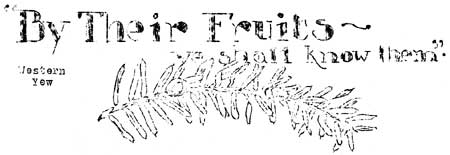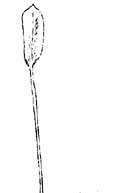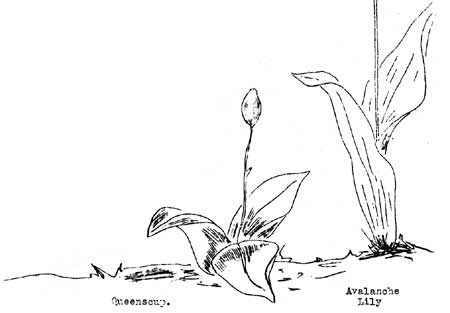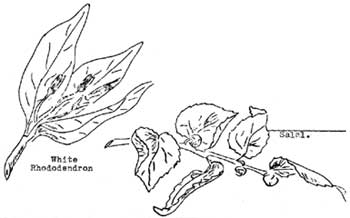
The biblical phrase which titles this article aptly describes many of
our flowering plants at this season. All of them, of course, bear fruit
or seeds but in some of these this character is so unique or conspicuous
that the beauty and interest of the plant in the fall season easily
outstrips its spring beauty.
|
Throughout the summer one may have wondered along the woodland trails
where the Western Yew tree grows and, in spite of several distinctions,
failed to recognize it as something other than a conifer or cone bearing
tree. The foliage of the Yew is very similar in general appearance to
that of some of its forest associates. But at this season we cannot
fail to note the difference. The fruit - a small hard seed partially
surrounded by a brilliant red, jelly-like covering or aril - is sharply
contrasted to the green of the tree's foliage. It cannot, in any way be
confused with a cone, and so the Yew at this season, stands very much
apart from its associates.
|

|

|
All along the roads within the park - and beyond its borders too in
some places - we see the bright red berries of the Red Elderberry and we
find, too, the large attractive leaves of the Devil's Club (attractive
so long as one does not touch them) rendered even more conspicuous by
the spike of brilliant crimson berries that characterizes this plant at
this time.

|
One of the most attractive of the herbacious plants in late summer
and early fall is the Queenscup or Alpine Beauty. By this time the
single white flower has given way to a beautiful turquois berry that
adequately holds the interest of the flower lover in this plant. And
where we have been accustomed to finding a multitude of blooms of the
familiar Avalanche Lily we now find in their place seed pods instead.
Unfortunately the flower of this plant is so beautiful that the seed
pod, however interesting, would have a hard time measuring up to its
predecessor's standards. This is not the case of the Western Anemone
though! True - the flower is beautiful in the early summer; but the
seed pods - shaggy mops of silken strands, each strand attached to a
seed - are to most people far more interesting than the flower which
they probably have not even associated with the unique fruit cluster of
the late summer. There is one interesting thing in the case of this
latter plant. The flower blooms upon a short stem but a few inches
above the ground. There is no need for the plant to be raised higher at
that season. But as the season progresses the stem continues to grow
until when the seeds are ripe and ready for dessimination the plant is
some twelve to fourteen inches tall. The reason? This plant depends up
the wind to scatter its seeds and so it raises its cluster of seeds,
high so that the wind may accomplish its purpose in this regard to
better advantage.
|

|
In the case of the Sweet-After-Death the feathery white cluster of
flowers give way to a small but unique crescent-shaped fruit. The
flowers of the White Rhododendron find their destiny in the capsule
which eventually splits into five parts to scatter the seeds. The
familiar Salal - of which two species are found in the park - bears dark
blue (almost black) berry while the Oregon Grape receives its name not
from the flower but from the fruit. So does the Huckleberry. There's a
natural fruit that's really appreciated!
(C.F.B.)
Click to see a copy of the pages
of the original article (~111K)

